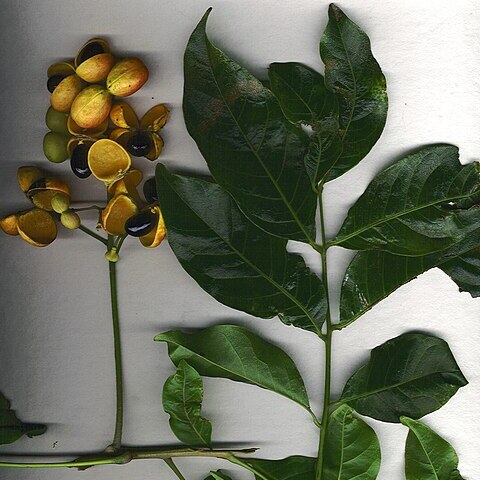Shrubs or trees, dioecious. Leaves paripinnate, estipulate; rachis and petiole sometimes winged; leaflets often entire. Thyrses compound racemose or sometimes racemose, terminal or axillary; bracts and bracteoles small. Flowers functionally unisexual, actinomorphic. Sepals 5, imbricate, persistent or deciduous. Petals 5, subcuneate, longer than calyx, slightly fleshy, scales absent, apex reflexed, or petals subspatulate, distinctly clawed, adaxially with 2 earlike, thin scales ca. 2 × as long as calyx. Disk small. Stamens (male flowers) 5-8, nearly as long as petals, conduplicate in flower buds; anthers ellipsoid. Ovary (female flowers) globose or ovoid, sessile or shortly stalked, bilaterally compressed, 2(-4)-loculed; ovules 1 or 2 per locule, pendulous; style short or long, twisted. Capsules usually compressed, 2(-4)-loculed, grooved between locules; pericarp papery or crustaceous. Seeds 1 or 2 per locule, ellipsoid or ovoid; testa shiny, thinly crustaceous, often with white or orange fleshy aril; embryo curved, cotyledons fleshy. 2n = 30.
Shrubs or trees, usually dioecious. Indumentum of stellate and simple hairs. Leaves paripinnate; rachis and petiole sometimes winged; leaflets usually alternate, mostly entire, petiolulate or sessile. Inflorescence axillary, rarely terminal or ramiflorous, panicle-like; bracts subulate. Flowers regular. Sepals usually 5, free, imbricate. Petals usually 5, oblong-obovate, sessile or clawed then with 2 inflexed auricles, thick or membranous. Disc small, complete. Stamens 5–8; filaments glabrous. Ovary 2-locular; ovules 1 or 2 per locule; style reflexed or spiral at apex. Fruit usually stipitate, mostly 2-lobed, apiculate, inflated, loculicidally 2-valved. Seeds 1 or 2 per locule, subglobose or ellipsoidal, black, shiny; aril entire, nearly covering seed, rarely minute or absent.

